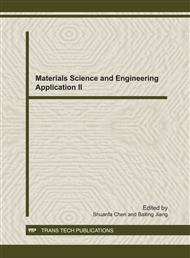p.270
p.277
p.283
p.289
p.295
p.300
p.304
p.308
p.314
Study on Wear and Friction Resistance of CrTiAlMoN Coatings Deposited by Magnetron Sputtering
Abstract:
The present research aims to synthesize a nanoscale multilayer CrTiAlMoN hard coating for the modification of wear and friction performance, as compare to CrTiAlN coatings. CrTiAlMoN coatings were deposited on 1045 carbon steel substrates by magnetron sputtering at different Mo target current. The wear and friction resistance were characterized by pin-on-disc test. When a WC-Co ball was used as the counterpart, the coefficients of friction of CrTiAlMoN coatings were found to decrease with the increase of Mo target current, with the lowest value (0.34) being only one half that of CrTiAlN coating (0.76). The combination of high hardness above 36GPa and low coefficients of friction reduces the specific wear rate of the CrTiAlMoN coatings to only 10% of CrTiAlN coatings. When tested against a bearing steel ball, results demonstrate that the effect of Mo on reducing friction of the CrTiAlMoN coatings is not significant and even negative due to adhesive wear.
Info:
Periodical:
Pages:
295-299
Citation:
Online since:
December 2011
Authors:
Price:
Сopyright:
© 2012 Trans Tech Publications Ltd. All Rights Reserved
Share:
Citation:


